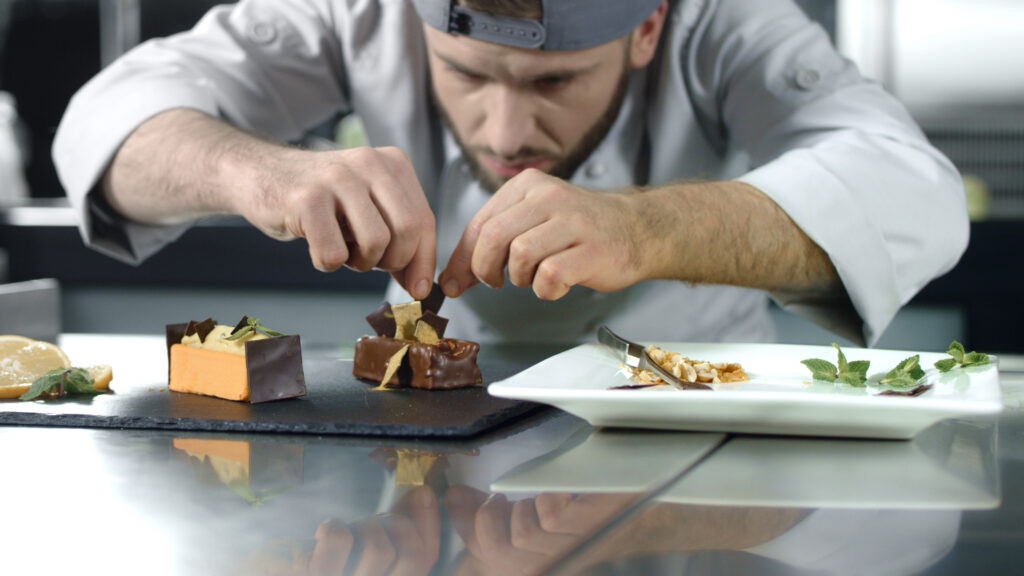Key Takeaways:
- Culinary adventures offer a unique exploration of flavors and tastes from around the world.
- Exotic flavors and unique delicacies are waiting to be discovered.
- Asia, South America, Europe, Africa, and more offer diverse and vibrant culinary experiences.
- Weird and wonderful foods provide an adventurous eating experience.
- Street food is a window into a city’s soul and offers quick bites of local flavors.
The Unforgettable Flavors of Asia

Asia is a culinary wonderland, offering a breathtaking array of flavors that will transport you on a gastronomic adventure like no other. From the vibrant street food vendors to the rich culinary traditions, this vibrant continent is a treasure trove of unique tastes and aromas.
One cannot talk about Asian cuisine without mentioning the captivating street food culture that permeates every corner. The bustling night markets of Taiwan, the aromatic satay stalls of Indonesia, and the sizzling stalls of Pad Thai in Thailand are just a few examples of the diverse street food scene that awaits eager food enthusiasts.
Asian street food is a symphony of flavors, a sensory explosion that defies boundaries and leaves an indelible mark on your taste buds.
But it’s not just about street food. Asian culinary traditions run deep, with each country boasting its own distinct techniques, ingredients, and cultural influences. From the delicate artistry of Japanese sushi to the fiery heat of Indian curries, the culinary landscape of Asia is as diverse as its landscapes.
Let’s take a closer look at some iconic dishes from different countries:
Thailand
- Pad Thai: A stir-fried rice noodle dish, bursting with flavors of tamarind, chili, and lime.
- Green Curry: A spicy coconut-based curry, best enjoyed with fragrant jasmine rice.
Japan
- Sushi: Delicate bites of vinegared rice topped with fresh seafood or vegetables, a true culinary artform.
- Ramen: Noodles immersed in a flavorful broth, with endless variations to satisfy every craving.
China
- Xiao Long Bao: These delicious steamed dumplings are filled with juicy meat and a burst of flavorful soup.
- Peking Duck: Crispy-skinned duck served with thin pancakes, scallions, and hoisin sauce, a classic and indulgent dish.
These are just a few examples of the incredible flavors that await in Asia. Whether you’re exploring the street food scenes of Bangkok or Tokyo, or indulging in a Michelin-starred Asian fusion restaurant, you’ll find yourself immersed in a world of taste sensations that will leave a lasting impression.
| Country | Iconic Dish | Description |
|---|---|---|
| Thailand | Pad Thai | A stir-fried rice noodle dish, bursting with flavors of tamarind, chili, and lime. |
| Japan | Sushi | Delicate bites of vinegared rice topped with fresh seafood or vegetables, a true culinary artform. |
| China | Peking Duck | Crispy-skinned duck served with thin pancakes, scallions, and hoisin sauce, a classic and indulgent dish. |
South America’s Gastronomic Wonders
South America is a culinary treasure trove, offering a vibrant tapestry of flavors and dishes that will transport your taste buds on a delicious journey. From traditional recipes passed down through generations to innovative fusion flavors, the cuisine of South America is a true culinary marvel.
Experience the explosion of flavors in traditional dishes like ceviche, a refreshing seafood delicacy marinated in tangy citrus juices, or empanadas, savory pastries filled with meat, cheese, or vegetables. These dishes reflect the rich culinary heritage of the region and showcase the use of fresh, local ingredients.
But South American cuisine doesn’t stop at traditional dishes. It embraces fusion flavors, bringing together ingredients and techniques from different culinary traditions. This creates a unique blend of tastes that will tantalize your palate and ignite your sense of adventure.
Get ready to indulge in a culinary symphony of flavors as we explore South America’s gastronomic wonders.
Europe’s Culinary Delights

Europe is a gastronomic paradise, enticing food lovers with its diverse and tantalizing cuisine. From the refined elegance of Michelin-starred restaurants to the rustic charm of local specialties, this continent offers a feast for the senses.
Michelin-Starred Magic
For those seeking an unforgettable dining experience, Europe boasts an impressive selection of Michelin-starred restaurants. These culinary temples are renowned for their impeccable service, meticulous attention to detail, and innovative creations that push the boundaries of taste.
“The Michelin-starred chefs in Europe are true culinary artists, combining precision and creativity to deliver extraordinary dishes that leave a lasting impression on diners.”
Some of the most celebrated Michelin-starred restaurants in Europe include:
- El Celler de Can Roca – Girona, Spain
- Osteria Francescana – Modena, Italy
- Noma – Copenhagen, Denmark
- Arzak – San Sebastian, Spain
- Eleven Madison Park – New York City, USA
Local Specialties
While Michelin-starred restaurants showcase the pinnacle of European cuisine, it is the local specialties that truly capture the essence of each region. In charming villages and bustling city markets, you’ll discover a treasure trove of flavors that have been passed down through generations.
“Exploring Europe’s local specialties is like embarking on a culinary journey through time, uncovering traditional recipes and age-old cooking techniques that have stood the test of time.”
Here are just a few examples of the delightful local specialties you can savor across Europe:
- Paella – Valencia, Spain
- Pasta Carbonara – Rome, Italy
- Wiener Schnitzel – Vienna, Austria
- Croissant – Paris, France
- Baklava – Istanbul, Turkey
Whether you indulge in the refined elegance of a Michelin-starred restaurant or savor the rustic charm of a local specialty, Europe’s culinary delights are sure to leave you craving for more.
Exotic Delicacies from Africa
African cuisine is a hidden gem waiting to be discovered. The rich and diverse culinary landscape of this vast continent offers a tantalizing taste journey influenced by its vibrant cultural heritage. From South African bobotie to Ethiopian injera, African cuisine showcases unique ingredients and flavors that are sure to ignite your senses.
The Unique Ingredients of African Cuisine
One of the defining characteristics of African cuisine is the use of indigenous ingredients that are not commonly found in other parts of the world. From the red palm oil and egusi seeds of West Africa to the sorghum and millet used in East African dishes, African cooks utilize local resources to create dishes that are both delicious and nutritious.
| African Ingredient | Description | Key Dishes |
|---|---|---|
| Plantains | A starchy fruit with a subtle sweetness, similar to bananas | Moin Moin (Nigeria), Kelewele (Ghana) |
| Okra | A green vegetable known for its slimy texture when cooked | Gumbo (West Africa), Bamia (Egypt) |
| Berbere | A spicy Ethiopian spice blend made with chili peppers, garlic, and other aromatic spices | Doro Wat, Tibs (Ethiopia) |
| Biltong | A type of dried and cured meat, similar to beef jerky | Biltong (South Africa), Droëwors (Namibia) |
These unique ingredients not only contribute to the distinct flavors of African dishes but also reflect the continent’s rich biodiversity and agricultural traditions. Exploring African cuisine is an adventure that goes beyond taste, offering a glimpse into the vibrant cultures and traditions that have shaped this remarkable continent.
“African cuisine is a reflection of the continent’s diversity and cultural influences, blending indigenous ingredients with flavors introduced through trade and colonialism.”
Unconventional Eats: Weird and Wonderful Foods

Do you have a bold and adventurous palate? Are you willing to step outside your culinary comfort zone and try something truly unusual? Then brace yourself for a gastronomic rollercoaster as we embark on a journey into the world of weird and wonderful foods. From strange ingredients to bizarre cooking methods, this culinary adventure promises to push the boundaries of your taste buds.
Unconventional eats come in many forms, ranging from insects that are considered delicacies in certain cultures to fermented foods with unique flavors. These weird foods may be unfamiliar to the average diner, but for those seeking a taste of adventure, they offer an opportunity to explore new culinary horizons. By venturing beyond the realms of traditional cuisine, you’ll not only satisfy your curiosity but also gain a deeper appreciation for the diversity of gastronomic experiences around the globe.
Embrace Your Adventurous Spirit
Adventurous eating is not just about novelty; it’s about embracing the unknown and opening your mind to new possibilities. By stepping outside your comfort zone, you’ll discover flavors and textures you never thought possible. Take a leap of faith and surrender your preconceived notions of what constitutes a meal. Allow yourself to be tantalized by the peculiar and surprised by the extraordinary.
Unusual ingredients play a pivotal role in these unconventional eats. Whether it’s the pungent aroma of durian fruit, the tangy bite of fermented tofu, or the nutty crunch of fried crickets, these ingredients challenge our expectations and redefine what we consider edible. By sampling these unconventional flavors, you become part of an elite group of culinary thrill-seekers who dare to explore the uncharted territories of taste.
“One man’s weird food is another man’s delicacy.” – Anthony Bourdain
Delight in the Unexpected
Unconventional eats not only tantalize the taste buds but also ignite a sense of wonder. They invite us to question our assumptions and challenge our comfort zones. By embracing these unconventional delicacies, you embark on a culinary adventure that transcends the ordinary and transports you to a world of extraordinary flavors.
To whet your appetite for adventure, let’s delve into a selection of weird and wonderful foods that promise to intrigue and delight:
| Food | Country of Origin | Description |
|---|---|---|
| Balut | Philippines | A fertilized duck embryo boiled and eaten from the shell. |
| Hákarl | Iceland | Fermented shark meat with an overpowering ammonia-like odor. |
| Escamoles | Mexico | Ant larvae harvested from the roots of agave plants, prized for their buttery flavor. |
| Century Egg | China | A preserved duck, chicken, or quail egg with a gelatinous texture and a strong, ammonia-like flavor. |
| Haggis | Scotland | A savory pudding made from sheep’s pluck, traditionally encased in the animal’s stomach. |
These are just a few examples of the weird and wonderful foods that await those who dare to try. Each dish tells a story, representing a unique culinary tradition or cultural practice. By embracing these unconventional eats, you become an explorer, traversing uncharted territory and unearthing hidden culinary gems.
Buckle up and prepare for an unforgettable journey into the realm of weird and wonderful foods. Get ready to challenge your taste buds, expand your culinary horizons, and experience the thrill of adventurous eating. Remember, the world is full of surprises, and the most extraordinary flavors often lie just beyond what is conventionally considered edible.
An Ode to Street Food: Global Delights on-the-go

When it comes to experiencing the true essence of a city’s culinary scene, nothing beats the thrill of street food. From vibrant markets to bustling food carts, street food serves up a flavorful adventure like no other. It’s a melting pot of local flavors, quick bites, and authentic tastes that ignite your taste buds and transport you to the heart of a destination.
So, why is street food so special?
First and foremost, street food is a celebration of local flavors. It offers a chance to savor the regional specialties and secret recipes that have been passed down through generations. Whether you’re biting into a crispy banh mi in Vietnam or indulging in a hot empanada in Argentina, street food encapsulates the essence of a culture and its culinary heritage.
But street food is more than just delicious eats.
It’s also an opportunity to explore a city’s soul, immersing yourself in its vibrant street life and soaking up the local atmosphere. Picture yourself wandering through the bustling streets of Istanbul, where the aroma of sizzling kebabs fills the air, or navigating the alleys of Bangkok, where steaming bowls of noodles invite you to take a flavorful journey.
Street food vendors are the unsung heroes of the culinary world, often mastering their craft through years of dedication and passion. They create mouthwatering dishes right before your eyes, using simple ingredients yet delivering unforgettable flavors. And the best part? Street food is affordable, allowing you to taste a wide variety of dishes without breaking the bank.
Curious to know which cities offer some of the world’s best street food? Take a look at this table for a taste of the global street food scene:
| City | Must-Try Dish |
|---|---|
| Bangkok, Thailand | Pad Thai |
| Istanbul, Turkey | Doner Kebab |
| Mexico City, Mexico | Tacos al Pastor |
| Mumbai, India | Vada Pav |
| Hanoi, Vietnam | Pho |
These are just a few examples of the street food wonders that await you on your culinary adventures. So, the next time you find yourself in a new city, make sure to venture out and discover its street food scene. You never know what delicious surprises await!
The Surprising Tales of Food History
Food history goes beyond mere flavors; it is a tapestry woven with stories and rich traditions. Exploring the roots of beloved dishes can lead us on a fascinating journey through time, uncovering how culinary traditions have shaped cultures around the world.
The Origin Stories
Many iconic dishes have mysterious origins, and the history behind them is often as captivating as their taste. Let’s dive into a few intriguing examples:
“The humble pizza has a vibrant history that dates back centuries. Originating in Naples, Italy, it was initially a simple dish enjoyed by the working class. Today, it has gained global fame and countless variations, becoming a beloved symbol of Italian cuisine.”
Another dish with a fascinating history is sushi:
“Contrary to popular belief, sushi did not originate in Japan. Its roots are traced back to ancient China, where fermented fish and rice were preserved together. The modern form of sushi we know today emerged in Japan during the Edo period, leading to a culinary revolution that would capture the world’s palate.”
Culinary Traditions Passed Down Through Generations
Historical recipes serve as a testament to the dedication and craftsmanship passed down from one generation to the next. These traditional recipes offer glimpses into the cultural heritage of different communities.
One such example is the Mexican mole sauce, known for its complex flavors:
“The origins of mole sauce can be traced back to the pre-Hispanic era of Mexico. It is believed that the recipe has evolved over centuries, influenced by indigenous ingredients and Spanish colonization. Today, mole sauce is a cherished symbol of Mexican gastronomy, highlighting the diversity of its regional variations.”
Preserving Historical Recipes
Preserving historical recipes is vital to understanding our culinary heritage and ensuring that these time-honored traditions continue to be celebrated. Organizations and individuals around the world work tirelessly to document and share these recipes, keeping them alive for future generations.
In India, for instance, the “Eighth Foundation” initiative aims to safeguard traditional recipes:
“The ‘Eighth Foundation’ is dedicated to preserving the historical recipes of India’s diverse cuisines. By collecting, documenting, and sharing these recipes, they aim to nurture a deeper appreciation for India’s culinary traditions and promote sustainable practices in the food industry.”
The World on Our Plates
The tales of food history remind us that the world on our plates is a result of countless centuries of cultural exchange, migration, and invention. These stories connect us to our past and inspire us to explore new flavors.
Now that we have uncovered the surprising tales behind some of our favorite dishes, let’s dive deeper into fusion cuisine, where East meets West, in the next section.
Fusion Cuisine: Where East Meets West
Fusion cuisine is a culinary adventure that takes us on a journey where East meets West, melding together flavors and techniques from different culinary traditions. It’s a cross-cultural celebration of taste that results in a unique and exciting dining experience.
In fusion cuisine, chefs draw inspiration from their own cultural backgrounds and combine it with ingredients and cooking styles from other parts of the world. The result is a harmonious blend of flavors that creates new and exciting culinary possibilities.
Whether it’s the combination of traditional Japanese ingredients with French cooking techniques or the infusion of Mexican spices into classic Italian dishes, fusion cuisine pushes the boundaries of culinary creativity and offers a delightful fusion of flavors.
“Fusion cuisine is the art of marrying diverse culinary traditions to create dishes that are both familiar and innovative. It’s a celebration of diversity and a testament to the power of blending cultures through food.” – Chef Masaharu Morimoto
The beauty of fusion cuisine lies in its ability to combine the best of both worlds – the deep-rooted culinary traditions of different cultures and the modern techniques and ingredients that have become available in today’s globalized world. It’s a testament to the rich tapestry of flavors and the endless possibilities that arise when we embrace cross-cultural influences.
The Rise of Fusion Cuisine
Fusion cuisine gained popularity in the late 20th century when chefs started experimenting with blending culinary traditions to create unique dishes. This culinary movement was fueled by the increasing globalization, migration, and the desire for culinary exploration.
One of the pioneers of fusion cuisine was Chef Wolfgang Puck, who introduced the world to his famous dish, the Asian-inspired pizza topped with ingredients like soy sauce, ginger, and cilantro.
Today, fusion cuisine can be found in restaurants around the world, offering diners an exciting gastronomic experience that transcends cultural boundaries. It has become a reflection of our diverse world and a celebration of multiculturalism.
Exploring Cross-Cultural Flavors
One of the most exciting aspects of fusion cuisine is the exploration of cross-cultural flavors. Chefs experiment with combining ingredients and cooking techniques from different parts of the world, resulting in unexpected and delightful combinations.
For example, Korean tacos combine the bold flavors of Korean barbecue with the convenience and portability of a Mexican tortilla. The result is a mouthwatering fusion that brings together the best of both culinary worlds.
Another popular fusion dish is the sushi burrito, which combines the fresh and delicate flavors of sushi with the hearty and filling nature of a burrito. It’s a perfect fusion of Japanese and Mexican cuisines that satisfies both sushi lovers and burrito enthusiasts.
Celebrating Culinary Fusion
In the world of fusion cuisine, culinary boundaries are blurred, and creativity knows no limits. It’s a celebration of culinary diversity and a testament to the power of cross-cultural influences.
Whether you’re indulging in a Korean-Mexican fusion food truck, savoring a Thai-Italian fusion pasta dish, or trying a French-Japanese fusion dessert, fusion cuisine offers a unique and unforgettable culinary experience.
So, embark on a culinary adventure like no other and explore the world of fusion cuisine, where East meets West in a symphony of flavors and a celebration of culinary fusion.
A Lifetime of Culinary Adventures
As our culinary adventure comes to a close, it’s important to remember that the journey doesn’t have to end here. There is a lifetime of culinary adventures waiting to be explored. Whether you have a passion for food travel or simply enjoy the exploration of new flavors and cuisines, the world is your playground.
One of the most exciting aspects of a lifetime of culinary adventures is the opportunity to embark on food travel. Imagine immersing yourself in the vibrant street food markets of Bangkok, savoring the delicate flavors of French cuisine in the heart of Paris, or indulging in the spicy delights of Indian street food in Mumbai. With each destination, you’ll discover new flavors, cooking techniques, and culinary traditions that will enrich your palate and broaden your culinary horizons.
But the adventure doesn’t stop when you return home. Your own kitchen is a gateway to endless culinary exploration. Take inspiration from your travels and experiment with new ingredients, flavors, and cooking techniques. Dive into recipe books, watch cooking shows, and follow renowned chefs who share their expertise online. With practice, you’ll be able to recreate the flavors and experiences of your travels in the comfort of your own home, infusing your meals with the memories of your culinary adventures.
Remember, a lifetime of culinary adventures is not just about the food. It’s about the connections you make, the stories you hear, and the cultures you embrace. It’s about the shared joy of breaking bread with loved ones and the satisfaction of creating a delicious meal from scratch. So, embrace the world of flavors that awaits you, and let your taste buds guide you on a lifetime of culinary exploration.



































